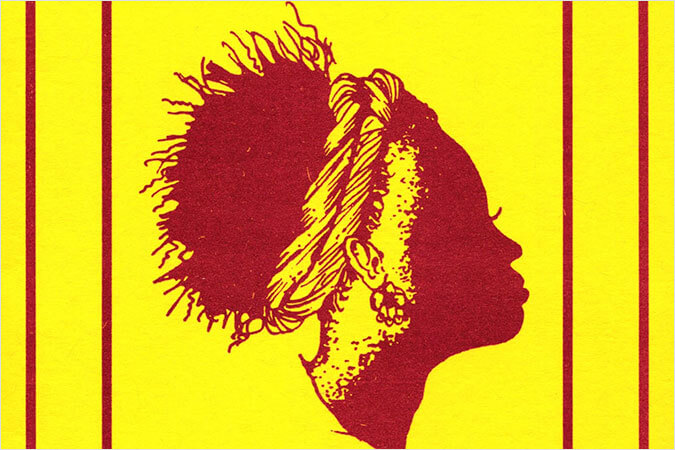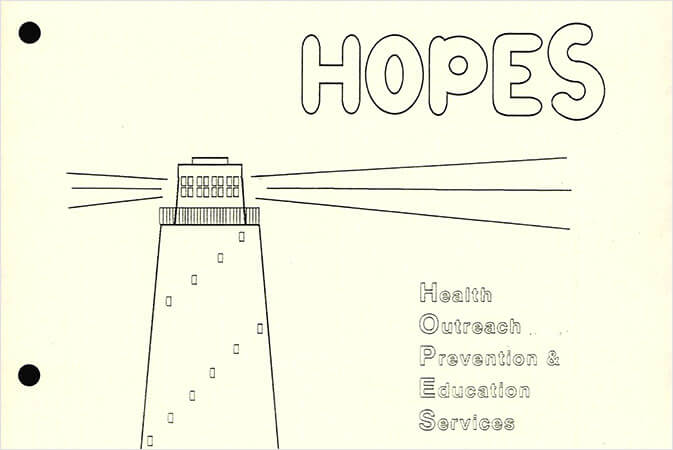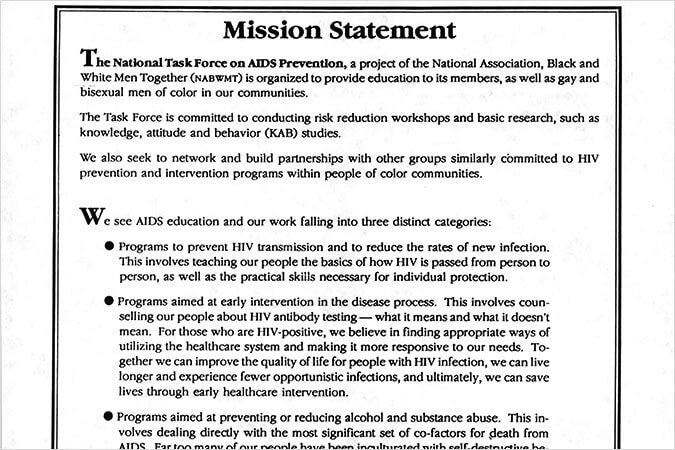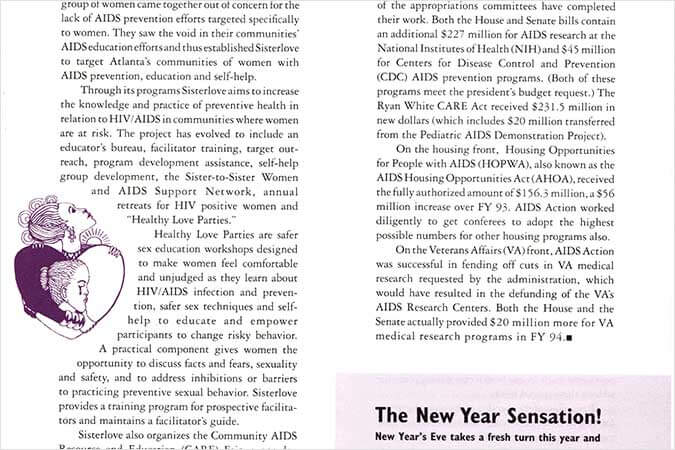This collection of ephemera documents early AIDS activism of BIPOC/racialized individuals and AIDS outreach campaigns targeting communities of color. In doing so, it aims to correct the misconception of the history of AIDS activism as being conducted mostly by white, middle-class, gay men. The goal of this project is to promote a more complete account of the history of AIDS and AIDS activism in America and to make visible the efforts of activists who faced both racism and homophobia when fighting for their lives and the lives of those who were from marginalized communities.
Organizational collections

American Indian AIDS Institute (AIAISF)
This early pamphlet published by AIAISF focuses on educating indigenous men about risks, HIV/AIDS, and its health and social services.

Bay Area HIV Support and Education Services (BAHSES)
BAHSES came out of the San Francisco Chapter of the Black and White Men Together (BWMT) AIDS Task Force, which was formed in 1985. It was a non-profit organization dedicated to HIV education, prevention, services, and community building, with particular attention given to communities of color in San Francisco effected by the AIDS epidemic.

District of Columbia Women’s Council on AIDS
This 1990s pamphlet is from District of Columbia Women’s Council on AIDS. The council was founded by women in 1987 to support women impacted by HIV/AIDS. It promoted health education, facilitated access to healthcare and social services, offered programming to women who were not identified as having high risk behaviors, and support services to all women impacted by HIV/AIDS.

Early Advocacy & Care for HIV (EACH)
The National Task Force on AIDS Prevention funded and helped launch the EACH campaign, an effort to specifically outreach to gay men of color about safe sex, drug use, social isolation, and socio-economic status.

Health Force: Women Against AIDS
Health Force is a peer AIDS education and prevention program that was founded in the South Bronx, New York and focused on that community which was dealing with high unemployment, prolific drug use, and poverty. It started as a women’s program and then extended to men and children.

Health Outreach Prevention & Education Services (HOPES)
HOPES was a prevention peer education and advocacy service funded by the National Foundation AIDS. It aimed to offer services for people with HIV and to address concerns from individuals from communities of color. HOPES’ target population included women of the Native American Community and transgender individuals of Asian/Pacific Islander within San Francisco.

National Task Force on AIDS Prevention (NTFAP)
NTFAP was founded in 1988. Reggie Williams served as its Executive Director until 1994. The task force focused on collaborations with other people of color groups to advocate and conduct outreach to gay men of color.

Sisterlove
This spotlight article in the October/November 1993 edition of the AIDS Action Council Update features Sisterlove Women’s AIDS Project. Founded in Atlanta, Georgia in 1989, Sisterlove grew out of a volunteer group of women who were concerned about the lack of HIV/AIDS prevention and education efforts for women. SisterLove, Inc. is still in existence.

UMOJA SASA Products Corporation
Seeing a need for HIV/AIDS prevention outreach and education materials directed towards African Americans, Edwin Vernon Avent founded the UMOJA SASA Products Corporation in 1990. In the early 1990s, the company grew to include campaign targeting material for Latinx and Native American communities.
Collaborations and state-sanctioned outreach efforts

AIDS Knowledge, Attitudes, Beliefs and Behaviors in a Household Survey of Filipinos in San Francisco
The San Francisco Department of Public Health AIDS Surveillance Office worked in collaboration with The Asian American Health Forum and Filipino Task Force on AIDS to create a report based on a 1989-1990 survey to measure “AIDS knowledge, attitudes, beliefs and behaviors in San Francisco’s Filipino community.” See volume 1 of the report.

Center for Positive Care
Funded by the first round of the Ryan White CARE Funds in 1991, the Center for Positive Care was a collaborative effort between fifteen San Francisco organizations, including University of California, San Francisco (UCSF) AIDS Health Project (AHP), the California Prostitutes Education Project (CAL-PEP) and the National Task Force on AIDS Prevention (NTFAP) (NTFAP). It used a case manager approach to serve individuals from diverse communities.

California Department of Health – Multicultural Liaison Board
In 1991, the California Department of Health Services, State Office of AIDS, and the Multicultural Training Resource Center (MRTC) created the Multicultural Liaison Board (MLB). The main goal of the MLB was to address the needs of high-risk communities of color through programming and funding.

San Francisco AIDS Foundation – Crack and AIDS campaign
In 1990 the San Francisco AIDS Foundation reached out to members from the Black community to help develop a crack and AIDS campaign. The foundation had previously created a crack and AIDS outreach campaign that received negative feedback. Based off of meeting minutes, the visuals were not to blame or prevent drug us but rather focus on protection.

San Francisco Community College District ad hoc AIDS Education Committee
In 1986, a San Francisco Community College District (SFCCD) Ad Hoc AIDS Education Committee organized an AIDS awareness week. SFCCD featured a diverse student population, with a large number of newly-immigrated students, low-income adults, and adults enrolled in literacy programs. Planning, execution, and results from the week are detailed in an article authored by organizers of the week, Diana Bernstein and Chester A Roaman.

Shanti Project Multicultural Plan, 1990-1991
Founded in 1974 by Dr. Charles Garfield, the Shanti Project had been providing emotional support for people with life-threatening illnesses when the AIDS epidemic hit San Francisco. By 1984, the Shanti Project focused exclusively on AIDS. In 1991, this “AIDS service agency” was awarded funding from the James Irvine Foundation and the San Francisco Foundation to become more multicultural.
Further reading
Beadle-Holder, Michelle, “Black Churches Creating Safe Spaces to Combat Silence and Stigma Related to AIDS,” Journal of African American Studies, vol. 15, 2011, pp 248-267.
Berger, Michele Tracy. Workable Sisterhood: The Political Journey of Stigmatized Women with HIV/AIDS. Princeton, 2004.
Cohen, Cathy J. The Boundaries of Blackness: AIDS and the Breakdown of Black Politics. The University of Chicago Press, 1999.
“Endgame: AIDS in Black America.” Frontline, Season 2012, Episode 17, Produced by Renata Simone, 10 July 2012, https://www.pbs.org/wgbh/frontline/film/endgame-aids-in-black-america/ Accessed 11 May 2022.
Esparza, René. “‘Qué Bonita Mi Tierra’: Latinx AIDS Activism and Decolonial Queer Praxis in 1980s New York and Puerto Rico.” Radical History Review, no. 140, Duke University Press, NC & IL, 2021, pp 107–141.
Hammonds, Evelynn. “Race, Sex, Aids: The Construction of ‘Other’.” Radical America, 1986, pp. 28-36.
Johnson, Antoine S. “From HIV-AIDS to COVID-19: Black Vulnerability and Medical Uncertainty,” AAIHS, 15 June 2020, https://www.aaihs.org/from-hiv-aids-to-covid-19-black-vulnerability-and-medical-uncertainty/ Accessed 11 May 2022.
Richardson, Maxwell Baker. “Racial, Gender, and Sexual Imagery and the Black Queer Man.” Humanities | Gender and Queer Studies, vol. 1, no. 1, 2020, pp.1-9.
Royles, Dan. To Make the Wounded Whole: The African American Struggle against HIV/AIDS. The University of North Carolina Press, 2020.
Teaching questions
- This primary source collection website emerged as an attempt to help diversify the history of activism and experiences during the early years of the epidemic. What are some common themes found in the featured campaigns?
- These primary sources are grouped into two categories: BIPOC/racialized individuals generated material and ephemera from collaborations and/or state-sanctioned outreach efforts. How do these two types of campaign material similar? How are they different?
- Dázon Dixon Diallo is Founder and current President of SisterLove, Inc. Check out SisterLove, Inc.’s current website. How has the vision of the organization grown? How does the organization depict its history? What about the history of HIV/AIDS more generally speaking? What do their interpretations say about mainstream histories of the early decades of the AIDS epidemic in the US.?
- In 1988, Diana Bernstein and Chester A Roaman wrote about City College of San Francisco’s AIDS Awareness Week. What were the key elements of the week’s programming? What are describe the origins of the poster from this week featured on this website? What other organizations featured here on this website were also part of the programming for that week? How does the poster, programming, and collaborations speak to the type of organizing taking place during the early decades of the HIV/AIDS epidemic?